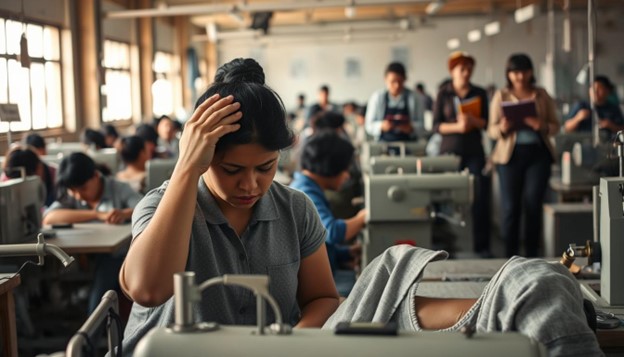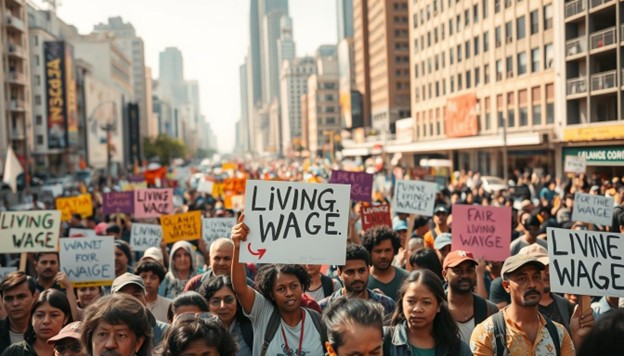
By Md Alam Hossain- The garment industry is huge, with millions working in it. But, it’s very stressful. This stress can hurt their mental health a lot.

It’s important to make a good work place for them. This helps them feel better and work better too.
We need to care for each other in this industry. This helps everyone feel better and work well together.
Key Takeaways
- Prioritizing mental health is crucial for garment workers’ overall well-being.
- A supportive work environment enhances productivity and industry performance.
- Understanding the demands on garment workers is key to promoting their well-being.
- Creating a culture of care is essential for garment worker mental health.
- Improving working conditions can significantly impact worker well-being.
The Current State of Mental Health in the Garment Industry
The global garment industry has millions of workers. It’s facing big mental health issues. We need to understand these problems to help workers.
Global Statistics and Trends
Many garment workers struggle with their mental health. They often feel stressed, anxious, and depressed.
Prevalence of Mental Health Issues
Garment workers face many mental health risks. Long hours, low pay, and bad work conditions are big problems. A study showed that nearly 60% of workers feel stressed. Also, 40% feel anxious.
Regional Differences
Where workers are from matters a lot. Workers in poor countries often have it worse. They face tough work and don’t get help for their mental health.

Economic Impact of Mental Health Challenges
Mental health issues cost the garment industry a lot. Here’s a table showing how much:
| Aspect | Impact | Potential Loss |
| Productivity | Reduced efficiency | Up to 20% |
| Absenteeism | Increased absences | Up to 15% |
| Turnover | Higher employee turnover | Up to 30% |
A mental health expert said,
“The garment industry’s mental health challenges are not just a worker’s issue, but also an economic one. Addressing these challenges can lead to significant benefits for both workers and employers.”
Understanding Garments Worker Mental Health Challenges
Garment workers face many challenges that hurt their mental health. These include work stress and money issues. The fast pace of the garment industry adds to the stress.
Work-Related Stressors
Stress at work is a big problem for garment workers. Two main reasons are the rush to produce and being bullied at work.
Production Pressure and Quotas
The need to hit production targets is very stressful. Workers often work long hours. This means they miss out on rest and personal time.
Workplace Harassment
Being bullied at work is another big stress. It hurts workers’ mental health and makes the workplace bad.

Socioeconomic Factors
Money issues and job insecurity also affect workers’ mental health. These problems cause worry about money and the future.
Cultural and Gender Considerations
Culture and gender roles make things harder for workers. Women, who are a big part of the workforce, face extra challenges. These include gender discrimination and balancing work and family.
It’s important to understand these challenges to help workers. Employers and leaders can make work better for everyone’s mental health.
The Impact of Working Conditions on Mental Well-being
The garment industry’s work conditions are key to workers’ mental health. Making these conditions better is vital for workers’ mental health.
Long Hours and Physical Strain
Garment factory workers face long hours and physical strain. This can hurt their mental health a lot. Working long hours without breaks can cause fatigue, stress, and mental health problems.
Physical strain from repetitive tasks and bad ergonomics makes things worse. It leads to a drop in mental health.
Workplace Environment
The workplace environment is very important for garment workers’ mental health. Things like facility safety and comfort help create a good work place.
Facility Safety and Comfort
A safe and comfy work place can lower stress and anxiety. It’s important to have good air, light, and temperature.
Social Dynamics
Good social vibes among workers help a lot. They create a sense of community and support. This is key for mental well-being. Teamwork and social chances help fight mental health issues.
Job Security Concerns
Job insecurity is a big stress for many workers. Worries about job safety and future jobs can cause anxiety and depression.
The Business Case for Mental Health Support
Helping garment workers’ mental health is good for business. It’s not just the right thing to do. It also helps a company’s profits and reputation.
Productivity and Quality Improvements
Mental health support makes workers more productive and focused. They can make better clothes. Happy customers and loyal customers are the result.
Reduced Turnover and Absenteeism
Supporting mental health means fewer workers leave. It also means they don’t miss as much work. This saves money on hiring and training.
Brand Reputation and Ethical Considerations
Companies that care about mental health look better to customers. Today, people want to buy from companies that are fair and kind.
Consumer Awareness and Demand
More people know how important mental health is in the garment industry. Companies that help their workers attract customers who care about fairness.
Certification and Compliance Benefits
Supporting mental health can also get a company certified. This makes them stand out in the market.
| Benefits | Description | Impact |
| Productivity Improvements | Enhanced worker focus and efficiency | Higher quality products |
| Reduced Turnover | Lower recruitment and training costs | Increased stability |
| Brand Reputation | Demonstrated commitment to ethical practices | Enhanced consumer trust |
Creating Supportive Workplace Policies
Developing Comprehensive Mental Health Policies
Employers should make mental health policies for garment workers. These policies should help workers get mental health help. They should also make people talk more about mental health without fear.
Work-Life Balance Initiatives
Work-life balance is key for garment workers’ mental health. Here’s how to do it:
Flexible Scheduling Options
Flexible work hours help workers balance work and life. It makes them less stressed and happier.
Paid Time Off Policies
Good paid leave lets workers rest. It’s vital for their mental health.
| Initiative | Benefits | Implementation |
| Flexible Scheduling | Reduces stress, improves work-life balance | Implement flexible start and end times |
| Paid Time Off | Allows for rest and rejuvenation | Offer generous paid leave policies |
Anti-harassment and Discrimination Measures
Employers must have strict rules against harassment and discrimination. This makes the workplace safe and respectful. They should train everyone and have a clear way to report problems.
With these policies, employers can really help garment workers’ mental health. This makes the workplace better for everyone.
Practical Strategies for Employers to Support Mental Health
To help garment workers feel better, employers need to support their mental health. This makes the workplace healthier and more productive.
Training Supervisors and Management
It’s important to train supervisors and managers to help with mental health. They can learn through Mental Health First Aid. This teaches them how to spot and help with mental health problems.
Mental Health First Aid
Mental Health First Aid helps supervisors know when someone needs help. It’s key for a supportive work place.
Empathetic Leadership Development
Leaders who care and understand their workers are crucial. They make the workplace better and more supportive.
Creating Safe Spaces for Communication
It’s important to have safe places for talking. This means having secret ways to give feedback and feeling safe to share worries.
Implementing Stress Reduction Programs
Stress-reducing programs are great for workers’ mental health. These can include on-site wellness activities and peer support networks.
On-site Wellness Activities
Things like yoga or meditation classes can help reduce stress. They make workers feel better overall.
Peer Support Networks
Peer support groups let workers share and support each other. This builds a community and helps against feeling alone.
Mental Health Resources for Garment Workers
Helping garment workers’ mental health needs many kinds of support. It’s key to make sure they get the help they need. This helps them feel better and work better too.
Counseling and Support Services
Counseling and support are very important for garment workers. They can get help through:
- In-house Mental Health Professionals: Having mental health experts on site helps right away. It also makes it easier for workers to ask for help.
- External Referral Networks: Working with outside mental health services gives workers more options for help.
Educational Materials and Workshops
Learning materials and workshops help a lot. They teach workers about mental health. This helps them know when they or their friends might need help.
Community-Based Resources
Using community resources adds more help for workers. This includes working with local mental health groups and community organizations.
By offering many kinds of mental health support, employers can help workers stay mentally healthy. Looking after mental health is good for workers and helps the whole garment industry do well.
Case Studies: Successful Mental Health Initiatives
Mental health in the garment industry has grown a lot. Both big brands and small factories are helping their workers feel better. This makes workers happier and helps the industry grow stronger.
International Brand Programs
Big brands are leading the way in mental health support. They show everyone how to help workers feel better and stay healthy.
H&M’s Worker Well-being Initiative
H&M started a big program to help workers’ mental health. They teach supervisors how to help workers with mental health problems. This has made workers happier and more productive.
Gap Inc.’s P.A.C.E. Program
Gap Inc.’s P.A.C.E. program helps women workers a lot. It teaches them life skills and supports their mental health. This has made a big difference in their mental health.
Local Factory Initiatives
Local factories are also working hard on mental health. They team up with health groups and NGOs to help workers.
Some factories have started stress workshops and counseling. They know that mental health is key to a happy and strong team.
NGO and Government Partnerships
Working together is key for mental health in the garment industry. Factories, NGOs, and governments team up to make things better. They share resources and knowledge to help workers.
These partnerships have led to great mental health programs. They tackle the special challenges that garment workers face.
Measuring the Effectiveness of Mental Health Programs
To make sure mental health programs for garment workers work well, we need to check how they do. We look at how these programs help workers feel better and find ways to get even better.
Key Performance Indicators
Measuring success needs both numbers and feelings. Numbers tell us how many workers join programs and how much they work. Feelings tell us how workers really feel about these programs.
Quantitative Metrics
Numbers show us how far programs reach and their first results. For example, how many workers get counseling or feel less stressed at work.
Qualitative Assessments
Feelings give us deeper info about workers’ lives and how programs help them.
Feedback Mechanisms
Good ways to get feedback from workers are key. Surveys, groups, and talks with workers help us see what works and what doesn’t.
Continuous Improvement Approaches
Looking at numbers and feelings helps us make programs better. We might change what we offer or teach staff to support workers better.
FAQ
What are the most common mental health issues faced by garment workers?
Garment workers often face stress, anxiety, and depression. This is due to work stress, money issues, and cultural factors.
How do working conditions affect the mental well-being of garment workers?
Long hours and physical strain can hurt their mental health. So can a bad work environment. Safety, comfort, social life, and job security also play a role.
What can employers do to support the mental health of garment workers?
Employers can make mental health policies. They can help workers balance work and life. They should also train leaders on caring for mental health.
What resources are available to support the mental health of garment workers?
There are counseling services, educational programs, and community help. Employers can use their own mental health teams or find outside help.
How can the effectiveness of mental health programs be measured?
Programs can be checked by looking at numbers and feedback. It’s also good to keep improving and listening to workers.
What are some successful mental health initiatives in the garment industry?
H&M’s Worker Well-being Initiative and Gap Inc.’s P.A.C.E. Program have worked well. Local efforts and partnerships with NGOs and governments also show promise.
Why is prioritizing garment worker mental health important for businesses?
It helps improve work quality and keeps workers happy. It also makes the brand look good. And it’s what customers want.




